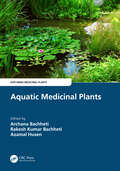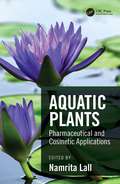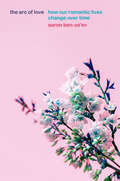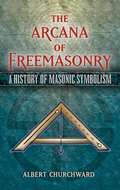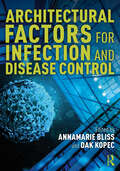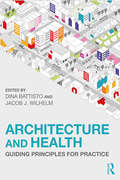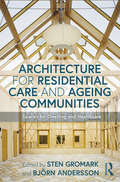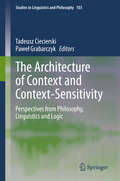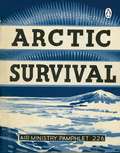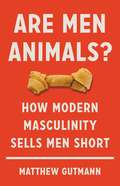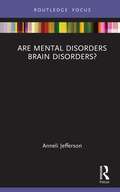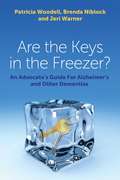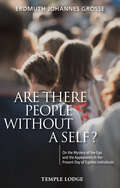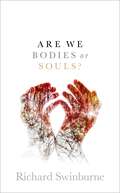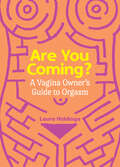- Table View
- List View
Aquatic Medicinal Plants (Exploring Medicinal Plants)
by Archana Bachheti Rakesh Kumar Bachheti Azamal HusenThe use of medicinal plants in herbal and modern medicine has gained popularity over the last few decades due to consumers taking more natural approaches to medicine. Aquatic medicinal plants are rich in bioactive compounds and demonstrate various commercial, nutraceutical, and biological applications. Aquatic Medicinal Plants offers the reader a wealth of information on uses of bioactive components of these plants, along with crucial references, and explains their traditional uses, phytochemistry, and pharmacological properties.Features Provides information on aquatic and semiaquatic medicinal plants and their uses globally. Discusses phytochemical components with the known active constituents and their pharmaceutical applications. This volume in the Exploring Medicinal Plants series is appropriate for scientists, experts, and consultants associated with the exploration of aquatic medicinal plant usage. This book is an essential tool for identifying important aquatic medicinal plants and possibilities for the synthesis or preparation of modern drugs.
Aquatic Plants: Pharmaceutical and Cosmetic Applications
by Namrita LallAquatic Plants: Pharmaceutical and Cosmetic Applications provides a concise description of popular aquatic plants found across the globe. The chapters in this beautifully illustrated, full-color book focus on the aquatic species native to specific continents. Written by a global team of experts, this book explains the distribution, ethnobotanical uses, genome sequencing, chemical compounds, and biological activity of these plants and addresses the cultivation and sustainable production of aquatic and wetland plants. Features: Describes the biological activity of a large collection of aquatic plants. Color photographs highlight each plant’s ethnobotanical characteristics, and structural formulae show their chemical constituents. Contributions come from leading scientists from countries including the United States, India, Mauritius, South Africa, and Cyprus. Aquatic Plants: Pharmaceutical and Cosmetic Applications is a valuable resource for academics conducting research on aquatic plants and for professionals in the pharmaceutical and cosmetic industries who are involved with the therapeutic applications of these plants and their sustainable usage.
Aquatic Plants: Pharmaceutical and Cosmetic Applications
by Namrita LallAquatic Plants: Pharmaceutical and Cosmetic Applications provides a concise description of popular aquatic plants found across the globe. The chapters in this beautifully illustrated, full-color book focus on the aquatic species native to specific continents. Written by a global team of experts, this book explains the distribution, ethnobotanical uses, genome sequencing, chemical compounds, and biological activity of these plants and addresses the cultivation and sustainable production of aquatic and wetland plants. Features: Describes the biological activity of a large collection of aquatic plants. Color photographs highlight each plant’s ethnobotanical characteristics, and structural formulae show their chemical constituents. Contributions come from leading scientists from countries including the United States, India, Mauritius, South Africa, and Cyprus. Aquatic Plants: Pharmaceutical and Cosmetic Applications is a valuable resource for academics conducting research on aquatic plants and for professionals in the pharmaceutical and cosmetic industries who are involved with the therapeutic applications of these plants and their sustainable usage.
The Arc of Love: How Our Romantic Lives Change over Time
by Aaron Ben-Ze'evIs love best when it is fresh? For many, the answer is a resounding “yes.” The intense experiences that characterize new love are impossible to replicate, leading to wistful reflection and even a repeated pursuit of such ecstatic beginnings. Aaron Ben-Ze’ev takes these experiences seriously, but he’s also here to remind us of the benefits of profound love—an emotion that can only develop with time. In The Arc of Love, he provides an in-depth, philosophical account of the experiences that arise in early, intense love—sexual passion, novelty, change—as well as the benefits of cultivating long-term, profound love—stability, development, calmness. Ben-Ze’ev analyzes the core of emotions many experience in early love and the challenges they encounter, and he offers pointers for weathering these challenges. Deploying the rigorous analysis of a philosopher, but writing clearly and in an often humorous style with an eye to lived experience, he takes on topics like compromise, commitment, polyamory, choosing a partner, online dating, and when to say “I love you.” Ultimately, Ben-Ze’ev assures us, while love is indeed best when fresh, if we tend to it carefully, it can become more delicious and nourishing even as time marches on.
The Arc of Love: How Our Romantic Lives Change over Time
by Aaron Ben-Ze'evIs love best when it is fresh? For many, the answer is a resounding “yes.” The intense experiences that characterize new love are impossible to replicate, leading to wistful reflection and even a repeated pursuit of such ecstatic beginnings. Aaron Ben-Ze’ev takes these experiences seriously, but he’s also here to remind us of the benefits of profound love—an emotion that can only develop with time. In The Arc of Love, he provides an in-depth, philosophical account of the experiences that arise in early, intense love—sexual passion, novelty, change—as well as the benefits of cultivating long-term, profound love—stability, development, calmness. Ben-Ze’ev analyzes the core of emotions many experience in early love and the challenges they encounter, and he offers pointers for weathering these challenges. Deploying the rigorous analysis of a philosopher, but writing clearly and in an often humorous style with an eye to lived experience, he takes on topics like compromise, commitment, polyamory, choosing a partner, online dating, and when to say “I love you.” Ultimately, Ben-Ze’ev assures us, while love is indeed best when fresh, if we tend to it carefully, it can become more delicious and nourishing even as time marches on.
The Arc of Love: How Our Romantic Lives Change over Time
by Aaron Ben-Ze'evIs love best when it is fresh? For many, the answer is a resounding “yes.” The intense experiences that characterize new love are impossible to replicate, leading to wistful reflection and even a repeated pursuit of such ecstatic beginnings. Aaron Ben-Ze’ev takes these experiences seriously, but he’s also here to remind us of the benefits of profound love—an emotion that can only develop with time. In The Arc of Love, he provides an in-depth, philosophical account of the experiences that arise in early, intense love—sexual passion, novelty, change—as well as the benefits of cultivating long-term, profound love—stability, development, calmness. Ben-Ze’ev analyzes the core of emotions many experience in early love and the challenges they encounter, and he offers pointers for weathering these challenges. Deploying the rigorous analysis of a philosopher, but writing clearly and in an often humorous style with an eye to lived experience, he takes on topics like compromise, commitment, polyamory, choosing a partner, online dating, and when to say “I love you.” Ultimately, Ben-Ze’ev assures us, while love is indeed best when fresh, if we tend to it carefully, it can become more delicious and nourishing even as time marches on.
The Arc of Love: How Our Romantic Lives Change over Time
by Aaron Ben-Ze'evIs love best when it is fresh? For many, the answer is a resounding “yes.” The intense experiences that characterize new love are impossible to replicate, leading to wistful reflection and even a repeated pursuit of such ecstatic beginnings. Aaron Ben-Ze’ev takes these experiences seriously, but he’s also here to remind us of the benefits of profound love—an emotion that can only develop with time. In The Arc of Love, he provides an in-depth, philosophical account of the experiences that arise in early, intense love—sexual passion, novelty, change—as well as the benefits of cultivating long-term, profound love—stability, development, calmness. Ben-Ze’ev analyzes the core of emotions many experience in early love and the challenges they encounter, and he offers pointers for weathering these challenges. Deploying the rigorous analysis of a philosopher, but writing clearly and in an often humorous style with an eye to lived experience, he takes on topics like compromise, commitment, polyamory, choosing a partner, online dating, and when to say “I love you.” Ultimately, Ben-Ze’ev assures us, while love is indeed best when fresh, if we tend to it carefully, it can become more delicious and nourishing even as time marches on.
The Arcana of Freemasonry: A History of Masonic Symbolism
by Albert ChurchwardEgyptian hieroglyphics, Mayan carvings, and Greek mathematical notations figure prominently in this spellbinding true story of a mysterious order's secret history. Author Albert Churchward, a renowned symbologist and member of "the Craft," offers illustrated explanations of the meanings behind Masonic symbols. Churchward reveals Masonic messages hidden—in plain sight—within works of art, architecture, geometry, and literature.First published in 1915, The Arcana of Freemasonry examines still-relevant issues regarding the fraternal society's purpose and function in today's world. Generously illustrated with Masonic symbols, it explores the significance of the signs and tools of contemporary Freemasonry, including the two triangles—one upright, one reverse—that form the oft-seen square and compasses known as the "Key of Hiram." Initiates and experts alike will find this history both captivating and informative.
Architectural Factors for Infection and Disease Control
by AnnaMarie Bliss Dak KopecThis edited collection explores disease transmission and the ways that the designed environment has promoted or limited its spread. It discusses the many design factors that can be used for infection and disease control through lenses of history, public health, building technology, design, and education.This book calls on designers to consider the role of the built environment as the primary source of bacterial, viral, and fungal transfers through fomites, ventilation systems, and overcrowding and spatial organization. Through 19 original contributions, it provides an array of perspectives to understand how the designed environment may offer a reprieve from disease. The authors build a historical foundation of infection and disease, using examples ranging from lazarettos to leprosy centers to show how the ability to control infection and disease has long been a concern for humanity. The book goes on to discuss disease propagation, putting forth a variety of ideas to control the transmission of pathogens, including environmental design strategies, pedestrian dynamics, and open space. Its final chapters serve as a prospective way forward, focusing on COVID-19 and the built environment in a post-pandemic world.Written for students and academics of architecture, design, and urban planning, this book ignites creative action on the ways to design our built environment differently and more holistically.Please note that research on COVID-19 has exponentially grown since this volume was written in October 2020. References cited reflect the evolving nature of research studies at that time.
Architectural Factors for Infection and Disease Control
by AnnaMarie Bliss Dak KopecThis edited collection explores disease transmission and the ways that the designed environment has promoted or limited its spread. It discusses the many design factors that can be used for infection and disease control through lenses of history, public health, building technology, design, and education.This book calls on designers to consider the role of the built environment as the primary source of bacterial, viral, and fungal transfers through fomites, ventilation systems, and overcrowding and spatial organization. Through 19 original contributions, it provides an array of perspectives to understand how the designed environment may offer a reprieve from disease. The authors build a historical foundation of infection and disease, using examples ranging from lazarettos to leprosy centers to show how the ability to control infection and disease has long been a concern for humanity. The book goes on to discuss disease propagation, putting forth a variety of ideas to control the transmission of pathogens, including environmental design strategies, pedestrian dynamics, and open space. Its final chapters serve as a prospective way forward, focusing on COVID-19 and the built environment in a post-pandemic world.Written for students and academics of architecture, design, and urban planning, this book ignites creative action on the ways to design our built environment differently and more holistically.Please note that research on COVID-19 has exponentially grown since this volume was written in October 2020. References cited reflect the evolving nature of research studies at that time.
Architecture and Health: Guiding Principles for Practice
by Dina Battisto Jacob J. WilhelmArchitecture and Health recognizes the built environment and health as inextricable encouraging a new mind-set for the profession. Over 40 international award-winning projects are included to explore innovative design principles linked to health outcomes. The book is organized into three interdependent health domains—individual, community, and global—in which each case study proposes context-specific architectural responses. Case studies include children’s hospitals, rehabilitation facilities, elderly housing, mental health facilities, cancer support centers, clinics, healthy communities, healthcare campuses, wellness centers, healing gardens, commercial offices, infrastructure for developing countries, sustainable design, and more. Representing the United States, Africa, Asia, Europe, and Australia, each author brings a new perspective to health and its related architectural response. This book brings a timely focus to a subject matter commonly constricted by normative building practices and transforms the dialogue into one of creativity and innovation. With over 200 color images, this book is an essential read for architects, designers, and students to explore and analyze designed environments that promote health and well-being.
Architecture and Health: Guiding Principles for Practice
by Dina Battisto Jacob J. WilhelmArchitecture and Health recognizes the built environment and health as inextricable encouraging a new mind-set for the profession. Over 40 international award-winning projects are included to explore innovative design principles linked to health outcomes. The book is organized into three interdependent health domains—individual, community, and global—in which each case study proposes context-specific architectural responses. Case studies include children’s hospitals, rehabilitation facilities, elderly housing, mental health facilities, cancer support centers, clinics, healthy communities, healthcare campuses, wellness centers, healing gardens, commercial offices, infrastructure for developing countries, sustainable design, and more. Representing the United States, Africa, Asia, Europe, and Australia, each author brings a new perspective to health and its related architectural response. This book brings a timely focus to a subject matter commonly constricted by normative building practices and transforms the dialogue into one of creativity and innovation. With over 200 color images, this book is an essential read for architects, designers, and students to explore and analyze designed environments that promote health and well-being.
Architecture for Residential Care and Ageing Communities: Spaces for Dwelling and Healthcare
by Sten Gromark Bjö AnderssonArchitecture for Residential Care and Ageing Communities confronts urgent architectural design challenges within residential innovation, ageing communities and healthcare environments. The increasing and diversified demands on the housing market today call for alterability and adaptability in long term solutions for new integrated ways of residing. Meanwhile, an accentuated ageing society requires new residential ways of living, combining dignity, independence and appropriate care. Concurrently, profound changes in technical conditions for home healthcare require rethinking healing environments. This edited collection explores the dynamics between these integrated architectural and caring developments and intends to envision reconfigured environmental design patterns that can significantly enhance new forms of welfare and ultimately, an improved quality of life. This book identifies, presents, and articulates new qualities in designs, in caring processes, and healing atmospheres, thereby providing operational knowledge developed in close collaboration with academics, actors and stakeholders in architecture, design, and healthcare. This is an ideal read for those interested in health promotive situations of dwelling, ageing and caring.
Architecture for Residential Care and Ageing Communities: Spaces for Dwelling and Healthcare
by Sten Gromark; Björn AnderssonArchitecture for Residential Care and Ageing Communities confronts urgent architectural design challenges within residential innovation, ageing communities and healthcare environments. The increasing and diversified demands on the housing market today call for alterability and adaptability in long term solutions for new integrated ways of residing. Meanwhile, an accentuated ageing society requires new residential ways of living, combining dignity, independence and appropriate care. Concurrently, profound changes in technical conditions for home healthcare require rethinking healing environments. This edited collection explores the dynamics between these integrated architectural and caring developments and intends to envision reconfigured environmental design patterns that can significantly enhance new forms of welfare and ultimately, an improved quality of life. This book identifies, presents, and articulates new qualities in designs, in caring processes, and healing atmospheres, thereby providing operational knowledge developed in close collaboration with academics, actors and stakeholders in architecture, design, and healthcare. This is an ideal read for those interested in health promotive situations of dwelling, ageing and caring.
The Architecture of Context and Context-Sensitivity: Perspectives from Philosophy, Linguistics and Logic (Studies in Linguistics and Philosophy #103)
by Tadeusz Ciecierski Paweł GrabarczykThis volume addresses foundational issues of context-dependence and indexicality, which are at the center of the current debate within the philosophy of language. Topics include the scope of context-dependency, the nature of content and the character of input data of cognitive processes relevant for the interpretation of utterances. There's also coverage of the role of beliefs and intentions as contextual factors, as well as the validity of arguments in context-sensitive languages.The contributions consider foundational issues regarding context-sensitivity from three different, yet related, perspectives on the phenomenon of context-dependence: representational, structural, and functional. The contributors not only address the representational, structural and/or functional problems separately but also study their mutual connections, thus furthering the debate and bringing competing approaches closer to unification and consensus. This text appeals to students and researchers within the field.This is a very useful collection of essays devoted to the roles of context in the study of language. Its essays provide a useful overview of the current debates on this topic, and they put forth novel contributions that will undoubtedly be of relevance for the development of all areas in philosophy and linguistics interested in the notion of context. Stefano Predelli Department of Philosophy, University of Nottingham, Nottingham, UK
Arctic Survival (Air Ministry Survival Guide)
by A.M. Pamphlet 226THE ULTIMATE SURVIVAL GUIDE for anyone who thinks they'd survive the world's most hostile environments - or at least imagine they could do.-----------------------------First issued to airmen in the 1950s, the Air Ministry's Sea Survival guide includes original and authentic emergency advice to crew operating over the ocean. With original illustrations and text, these survival guides provide an insight to military survival techniques from a by-gone era. Packed with original line drawings and instruction in:- The best faces to pull to prevent frostbite and when you can expect bits of you to 'fall off', should you fail- How to build a structurally sound igloo- How to fashion a mask to prevent snowblindnessFocussing on the harshest of situations one can find oneself in, Arctic Survival is one of four reprints of The Air Ministry's emergency survival pamphlets. Others include:Jungle SurvivalDesert SurvivalArctic Survival
Are Men Animals?: How Modern Masculinity Sells Men Short
by Matthew Gutmann"Boys will be boys," the saying goes -- but what does that actually mean? A leading anthropologist investigatesWhy do men behave the way they do? Is it their male brains? Surging testosterone? From vulgar locker-room talk to mansplaining to sexual harassment, society is too quick to explain male behavior in terms of biology. In Are Men Animals?, anthropologist Matthew Gutmann argues that predatory male behavior is in no way inevitable. Men behave the way they do because culture permits it, not because biology demands it. To prove this, he embarks on a global investigation of masculinity. Exploring everything from the gender-bending politics of American college campuses to the marriage markets of Shanghai and the women-only subway cars of Mexico City, Gutmann shows just how complicated masculinity can be. The result isn't just a new way to think about manhood. It's a guide to a better life, for all of us.
Are Mental Disorders Brain Disorders? (Routledge Focus on Philosophy)
by Anneli JeffersonThe question of whether mental disorders are disorders of the brain has led to a long-running and controversial dispute within psychiatry, psychology and philosophy of mind and psychology. While recent work in neuroscience frequently tries to identify underlying brain dysfunction in mental disorders, detractors argue that labelling mental disorders as brain disorders is reductive and can result in harmful social effects. This book brings a much-needed philosophical perspective to bear on this important question. Anneli Jefferson argues that while there is widespread agreement on paradigmatic cases of brain disorder such as brain cancer, Parkinson's or Alzheimer’s dementia, there is far less clarity on what the general, defining characteristics of brain disorders are. She identifies influential notions of brain disorder and shows why these are problematic. On her own, alternative, account, what counts as dysfunctional at the level of the brain frequently depends on what counts as dysfunctional at the psychological level. On this notion of brain disorder, she argues, many of the consequences people often associate with the brain disorder label do not follow. She also explores the important practical question of how to deal with the fact that many people do draw unlicensed inferences about treatment, personal responsibility or etiology from the information that a condition is a brain disorder or involves brain dysfunction.
Are Mental Disorders Brain Disorders? (Routledge Focus on Philosophy)
by Anneli JeffersonThe question of whether mental disorders are disorders of the brain has led to a long-running and controversial dispute within psychiatry, psychology and philosophy of mind and psychology. While recent work in neuroscience frequently tries to identify underlying brain dysfunction in mental disorders, detractors argue that labelling mental disorders as brain disorders is reductive and can result in harmful social effects. This book brings a much-needed philosophical perspective to bear on this important question. Anneli Jefferson argues that while there is widespread agreement on paradigmatic cases of brain disorder such as brain cancer, Parkinson's or Alzheimer’s dementia, there is far less clarity on what the general, defining characteristics of brain disorders are. She identifies influential notions of brain disorder and shows why these are problematic. On her own, alternative, account, what counts as dysfunctional at the level of the brain frequently depends on what counts as dysfunctional at the psychological level. On this notion of brain disorder, she argues, many of the consequences people often associate with the brain disorder label do not follow. She also explores the important practical question of how to deal with the fact that many people do draw unlicensed inferences about treatment, personal responsibility or etiology from the information that a condition is a brain disorder or involves brain dysfunction.
Are the Keys in the Freezer?: An Advocate's Guide for Alzheimer's and Other Dementias (PDF)
by Brenda Niblock Jeri Warner Patricia WoodellAre the Keys in the Freezer? is an artful blend of practical advice and the compelling story of a family's search for the right care for their mother with dementia. This well-researched book is a must-read for families in the US looking for resources and ideas about care facilities, hospices, finances and costs of care, advance directives and other topics related to managing the affairs of the elderly with dementia. A story of conflict and of light-hearted moments, Are the Keys in the Freezer? is the rich personal testimony of a family's struggle to navigate the confusing world of dementia care choices for their mother. The book is an insider's guide to unravelling medical, legal, and regulatory issues that affect the quality of care for loved ones who cannot make care decisions for themselves. The book's easy, conversational tone turns complex issues into everyday language, making it an easy read for newcomers to the world of caring for people with Alzheimer's and other forms of dementia.
Are the Keys in the Freezer?: An Advocate's Guide for Alzheimer's and Other Dementias
by Patricia Woodell Brenda Niblock Jeri WarnerAre the Keys in the Freezer? is an artful blend of practical advice and the compelling story of a family's search for the right care for their mother with dementia. This well-researched book is a must-read for families in the US looking for resources and ideas about care facilities, hospices, finances and costs of care, advance directives and other topics related to managing the affairs of the elderly with dementia. A story of conflict and of light-hearted moments, Are the Keys in the Freezer? is the rich personal testimony of a family's struggle to navigate the confusing world of dementia care choices for their mother. The book is an insider's guide to unravelling medical, legal, and regulatory issues that affect the quality of care for loved ones who cannot make care decisions for themselves. The book's easy, conversational tone turns complex issues into everyday language, making it an easy read for newcomers to the world of caring for people with Alzheimer's and other forms of dementia.
Are There People Without a Self?: On the Mystery of the Ego and the Appearance in the Present Day of Egoless Individuals
by Ermuth Johannes Grosse‘That in our times a kind of supernumerary person is appearing who is egoless, who in reality is not a human being, is a terrible truth.’ – Rudolf SteinerAre there people on earth today who do not have a self – a human ego or ‘I’? The phenomenon of ‘egolessness’ – the absence of a human being’s core – was discussed by the spiritual teacher Rudolf Steiner in lectures and personal conversations. An egoless individual, he intimated, is an empty sheath through which other spiritual entities could operate. Erdmuth J. Grosse brings together many little-known quotations from Rudolf Steiner’s spiritual research and supports them with a wealth of disquieting reports, testimonies and examples from literature and politics. He places these insights within the broader context of the riddle of the human self, throwing light on the spiritual development of the individual and humanity as a whole.In this thought-provoking study, Grosse goes on to discuss the role of comets, the effects of cyanide on the human constitution – especially in the light of the Holocaust – and the hidden effects of ceremonial magic, occult lodges, cults and sects. In conclusion, he offers positive solutions to humanity’s present predicament by describing the healing impulses of social threefolding, the invisible spiritual beings seeking to help humanity, the role of the gods, the Christ impulse and the true goals of human evolution.
Are We Bodies or Souls?
by Richard SwinburneWhat are humans? What makes us who we are? Many think that we are just complicated machines, or animals that are different from machines only by being conscious. In Are We Bodies or Souls? Richard Swinburne comes to the defence of the soul and presents new philosophical arguments that are supported by modern neuroscience. When scientific advances enable neuroscientists to transplant a part of brain into a new body, he reasons, no matter how much we can find out about their brain activity or conscious experiences we will never know whether the resulting person is the same as before or somebody entirely new. Swinburne thus argues that we are immaterial souls sustained in existence by our brains. Sensations, thoughts, and intentions are conscious events in our souls that cause events in our brains. While scientists might discover some of the laws of nature that determine conscious events and brain events, each person's soul is an individual thing and this is what ultimately makes us who we are.
Are We Bodies or Souls?: Revised Edition
by Richard SwinburneWhat are humans? What makes us who we are? Many think that we are just complicated machines, or animals that are different from machines only by being conscious. In Are We Bodies or Souls? Richard Swinburne comes to the defence of the soul and presents new philosophical arguments that are supported by modern neuroscience. When scientific advances enable neuroscientists to transplant a part of brain into a new body, he reasons, no matter how much we can find out about their brain activity or conscious experiences we will never know whether the resulting person is the same as before or somebody entirely new. Swinburne thus argues that we are immaterial souls sustained in existence by our brains. Sensations, thoughts, and intentions are conscious events in our souls that cause events in our brains. While scientists might discover some of the laws of nature that determine conscious events and brain events, each person's soul is an individual thing and this is what ultimately makes us who we are.
Are You Coming?: A Vagina Owner's Guide to Orgasm
by Laura HiddingaFor everyone with a vagina, here's your ultimate guide to achieving orgasm—on your own or with a partner Real talk: When&’s the last time you had an orgasm? If you&’re in the vagina owner&’s club, you may well answer: way too damn long! Studies show that only 65 percent of straight women climax during sex (versus 95 percent of men). And regardless of orientation, the unfortunate truth is: For those of us with vaginas, climaxing isn&’t guaranteed. No more! Are You Coming? invites everyone with a vagina to take their sex life to the next level. . . .Come alone. For vagina owners, self-knowledge is the path to pleasure (yet, we&’ve faced eons of misinformation). Are You Coming? explains all: anatomy, toys to try, and what works for dozens of real people—no two alike.Come together! Seeking better sex with a partner? Read on for the thirteen types of orgasm, how to talk about sex (before and after), why &“foreplay&” is tragically misnamed, sex positions for every want and need—and more! Complete with quickie tips, line drawings, and fun celebrity quotes, this is the orgasm-seeker&’s guide to &“Oh!&”Are you coming?
